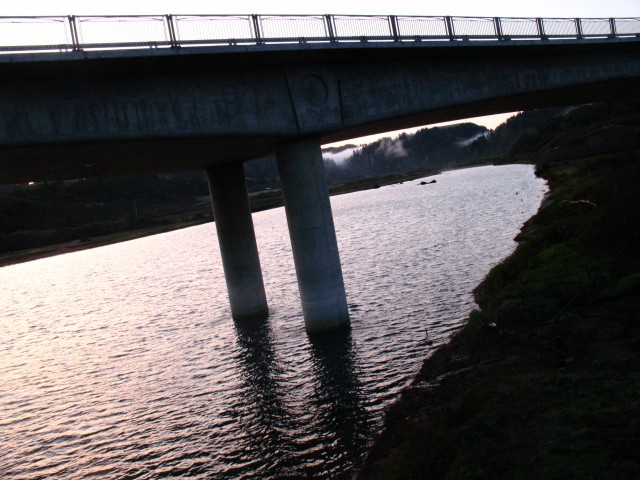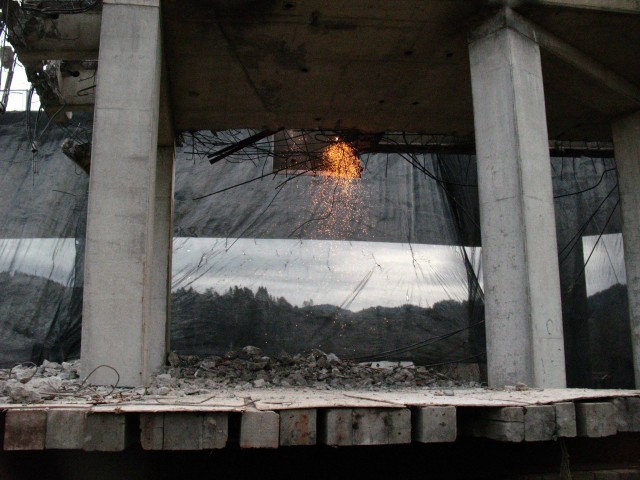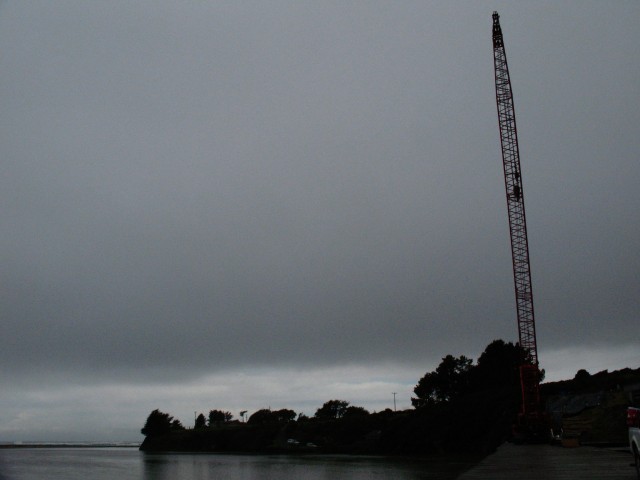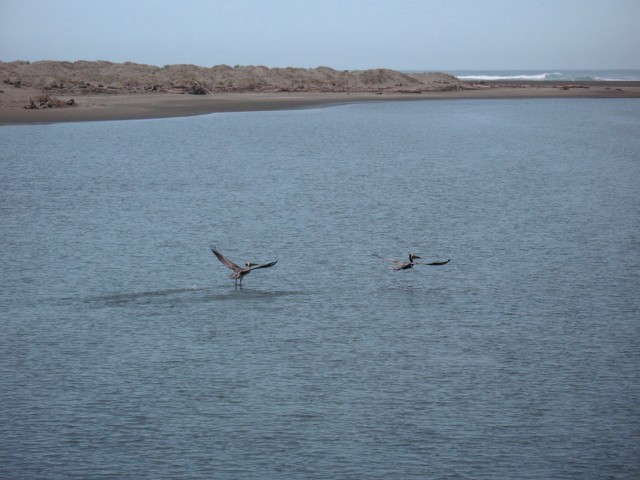Field Working Through the Corners
by Jordan Lennon Roberts

Working “in the field” or going on work trips makes up about 40 percent of the work I’ve done at my current job. The other 60 percent is generally spent sitting at a desk writing technical reports and emailing clients with occasional breaks when I read articles on websites and never comment on them. While I appreciate the variety of work, I prefer being in the field, especially a type of field work that involves monitoring the noise levels generated underwater during a particularly loud-ass construction method: pile driving.
I had no clue what this meant when I was starting out at our company. Turns out, building bridges can be complicated, and one way they do it is by banging huge cylindrical steel pipes (piles) into the ground to make sure things stays put. Driving these piles deep into the bedrock makes a lot of noise in some fairly sensitive and stunning environments, and the company I work for gets contracted to be “hydroacoustic monitors,” basically ensuring that the construction doesn’t make too much noise that would harm nearby wildlife, e.g., fish and marine mammals. A pile-driving job, for me, means getting out to a construction site at a time when I’m usually dreaming hard, and getting in position with equipment running properly before a construction crew starts literally hammering away. Just getting to a particular jobsite without wasting time can require some navigational skills and can cause some stress, but hanging out in nature-escape places I’ve never been to before and getting paid for it is nothing to complain about.
One job I worked on was a bridge replacement project spanning a river 10 miles north of Fort Bragg, California. Thus the name: Ten Mile River Bridge. I traveled to work for this job a number of times, and have broken down the getting-there into four portions:
Drive the ’98 Saab 900 I own from my apartment in Oakland to the office (a converted bungalow house) of the company I work for in Petaluma, California. This commute is committed to memory and a source of frustration in my life, despite how easy it is on the eyes. Approaching Petaluma, the grass-covered and cow-speckled hills are green in the spring and fade to gold as they dry out. Once in town proper, find a decent place to stay parked for a week. This is not difficult compared to parking in certain neighborhoods in certain cities at certain times when I have been on the verge of both tears and misdirected violence, but it’s something to consider.
Pack a bunch of equipment into the company car (’93 Subaru Outback) and rig up a trailer to tow with two kayaks and a pontoon boat tethered to it. Check that I have everything. Double-check that I haven’t forgotten anything. I’m not being redundant to be funny. This is a crucial step because forgetting things sucks, especially when those things are technical equipment that cannot be purchased at a local drugstore. Think about stopping for coffee. Now that it’s in my mind I will find a cold-brewed iced coffee or I will cry trying. The first shop I stop at only has the hot stuff so I say thanks and leave without getting anything, which I’m totally fine with in this case. I really love good hot coffee, just not at this time because I’m hell-bent. I find a good strong iced-coffee at another place before merging onto Highway 101 North. The merge happens slower than I like, because someone driving a cream colored 1960s VW van in decent condition has managed to get ahead of me on the on-ramp. Driving north out of Petaluma, I pass through the towns Rohnert Park, Santa Rosa, Healdsburg, and Windsor. This is wine country; even Nicolas Cage’s uncle Francis Ford Coppola has a winery here. It’s a pretty area but I’m really looking forward to what’s ahead.

The next leg should be a fun drive for most drivers. I realize that consistency is a good rule to follow, but I’m adamant about describing the next particular stretch of road in a commanding, somewhat instructional way, and therefore we’re driving right into the second person point-of-view.
Driving the Anderson Valley Highway (SR-128) from Highway 101 to Shoreline Highway 1 (CA1), you pass through numerous quaint towns ideal for witness protection relocation. This part of America is scenic and the route is quite varied, with sharp curves, straight-aways, and an array of contorted trees as you split hillsides, all book-ended with jaunts through woods. It is impressive. However splendid the journey, it is still annoying to get stuck behind a delivery truck or leisurely driver. Yes, looking at pretty things is nice (just agree), but you can perform the additional and more thrilling act of testing a vehicle’s handling here. Actually the beauty of the landscape is not compromised by quickly cutting through the narrow valley, provided there’s sunlight. You don’t have to be training for Formula-1 to enjoy the speed allowed by roads that forgivingly hug your tires. This should be within your comfort zone of traffic safety. Some slowpokes will pull out for you but that’s only if you’re lucky.
The largest of the small towns along this stretch of the State Route used to be called The Corners but is now called Boonville (population just over one thousand). Don’t pretend to know it intimately, but feel free to stop for food, gas, cigarettes, and road-trip beverages. This town is your acquaintance. Anderson Valley Brewing Company is located here, as you might know from drinking their beers and reading their labels, which feature a large bear with antlers. Despite the lure of the brewery, it’s probably not a great idea since you’re passing through on a work trip and there’s a significant drive ahead before reaching Fort Bragg. They’re probably not open right now anyway. Not the case? Then go for it and stop for a couple cold ones if you want, who’s stopping you? Be your own maker.
Another notable aspect of Boonville is that the locals invented their own “folk” language called Boontling sometime in the late 1800s. Phrases such as “Rudy nebs” (pristine, mineral rich, well water) and “Bahl Hornin” (good drinking) are some favorites. The wiki page for this oddball (dare you to call it hillbilly) language is fascinating.
You should get gasoline in Boonville if you’re below a quarter-tank. Although it’s only about 30 miles to the coast from town, gas stations are sparse out this way, and it just seems like a logical place to stop. Heading northwest out of town there’s a nice straightaway where you don’t suspect any cops with radar guns looming, so you can punch it. Farther ahead are more curves and switchbacks, and then the village and redwood grove called Navarro pops up. All of a sudden there are huge tree trunks inches from the pavement, and a few cause the road to buckle upward in little lumps you might want to avoid. It’s not like you’ll spiral-flip your vehicle if you hit one, but that’s what you imagine, which, how fun would that be — if you did just one mid-air roll and landed it? As you approach Coastal Highway 1, you round a corner and it feels like you’re being spit out of the woods and right into the Pacific Ocean. From here you can veer either northbound or southbound.
Since I have a precise destination and this is not a ‘choose your own adventure’ let’s switch back to first-person point-of-view. I’m heading north, winding up a seaside cliff. The town of Mendocino, in all its gorgeous hippie glory, seems intentionally removed from the main roadway. It is quite a looker of a town, perched atop a large ocean cliff jutting out like the land was hoping for a bunch of animals (human or otherwise) to gather there and hang out for a while. There is what can be called a downtown, because there are a dozen or so building façades all in a row, all town-like. But I must move on to harder working towns, oh Fort Bragg you’re so hard working.
Some people are good looking and they don’t have to work very hard, while some people are hard working and they don’t have to look very good. You can also categorically generalize towns in this same manner. Although the west coast’s Fort Bragg is nothing to sneeze at, looks-wise, it’s not going for the enchanting or charming aesthetics that County namesake Mendocino has going for it. I hope I’m not slighting Fort Bragg here, because sheesh, this whole area has many attractions, I just get the impression that this town let itself develop according to human needs and sprawled somewhat naturally instead of limiting itself. The streets are planned in a grid according to cardinal directions, which I truly appreciate, having lived in Chicago. (I am fairly confident in the accuracy of this.)
Regardless, Fort Bragg is a town with much to offer, including a hotel I need to stay at and a variety of restaurants/bars I want to frequent. I will play Rick Steves’ domestic correspondent and feature two such businesses: North Coast Brewing Company and Piaci Pub & Pizzeria. The former being a somewhat well-known brewery with good food and better beer (I’m looking at you Old Rasputin), the latter being a smaller place with surprisingly good pizza, and which I never want to leave. After a couple strong brews I strike up a conversation (go figure) with a dude who lived in the neighborhood of Rogers’ Park in Chicago at the same time as I did, and it turns out we both went to open-mic nights at Heartland Café, probably had some drunken exchanges years ago, and we wow ourselves over the odds of our meeting. Shouldn’t we all go ape-shit when these things come up? We want to play it cool and act like we’ve been there before, but do small-world stories ever get old? Probably to some, but I tend to think that the more weird coincidences keep happening, the harder it is to stay disgruntled or jaded. Say “SMALL WORLD, HUH?” with pride, because that means you talk to people and you get along and live in places to be proud of, mostly. Camaraderie. This digression makes total sense, so go to sleep in a Fort Bragg hotel room already.
I wake up way too early, there’s no snooze button-hitting this time. I meet my coworker in the lobby, and we pile in the old Subaru after making sure the boats are secure in the pre-dawn light. We drive north out of town, and 10 miles later we duck off Highway 1 onto a dirt road. Idling our way down the side of a cliff, we approach the construction site, where a safety meeting is just under way. We don’t have to attend because our safety meeting is an unspoken “don’t get hurt.” So we roll past the construction crew with a nod. These dudes aren’t thrilled with our presence, because who are we to possibly say they have to stop doing their job because they’re being too loud trying to do their job? Noise nerds, that’s who. I should make a superhero costume (no I shouldn’t). Depending on the type of animals living near a project, we use different noise metric thresholds (that have been set by an agency). Hopefully before noise gets too close to a threshold we let a foreman or some boss know. We don’t make the rules, we just monitor and then later chart up and analyze the data — basically observe and report. In that way we’re not exactly noise police, but we are expected to tattle. Usually the construction crews warm up to us a little, but not before a cold shoulder treatment. Admittedly we can be pesky, always asking what they’re planning on doing and when.

So they’re building a temporary trestle, which is basically a wooden platform for the crane to work from while they demolish the old bridge that’s already been replaced. The trestle is built in segments, and currently one segment is hanging about 20 feet out over the water. They will drive piles into the sediment for the next segment, and we need to set up three noise-monitoring stations in the water: two farther from the action (upstream and downstream) and one closer in. Thus the boats: one is a little inflatable pontoon-style thing that I tie to a kayak that, in turn, is tied to another kayak. I get in the lead kayak and trail the others to the downstream location and set an anchored buoy, so pontoon and expensive equipment perched on the seat don’t float down river and out into the ocean. The ocean is visible from the project site, just beyond the sand dunes adjacent to the riverbank. There are tons of snazzy birds coming and going and chilling around these parts including egrets, Great Blue Herons (my mom absolutely loves seeing a GBH), and those mystical lingering dinosaurs called pelicans.

The sun has risen now above a hilltop pine tree horizon opposite the ocean-side horizon. Fog is burning off the lower atmosphere to reveal a pink-orange-blue sky. I finish setting up the equipment, which includes placing a hydrophone at a certain depth in the water and starting a sound level meter. I make sure ambient levels are in an expected range, and then I start to paddle over to the upstream location. This is the part I can’t complain about at all. Not only is it serene and calming and something I usually would not get to do, let alone make money doing, but OH LOOK a fucking seal has decided to surface 20 yards from me to check me out. “Hey little buddy” in a hushed, high pitch voice is almost impossible for me to avoid saying. He or she looks at me with those huge black eyes and ducks back under, unimpressed. So I go about my business and set up the other kayak with equipment running just like the other monitoring system and then start to cruise without urgency toward shore. After a few paddles, I notice some movement along the surface of the water maybe 50 yards away. It’s converging with the path I’m on and I slow down. As the shimmering approaches I recognize that it is an entire family of otters! I don’t know if they’re sea otters or river otters, because water toward the mouth of the river is quite brackish and I’m not a biologist. They get within 15 feet and I’m surprised they’re not scared under by me, no, they continue playfully swimming all leisurely. One is obviously a parent and there are two littler ones. Geez they are cute.
Usually I try to avoid being cheesy and/or using clichés, but at a moment like this I can’t help thinking phrases like, “Well if this isn’t nice, I don’t know what is,” “hard work pays off,” and “early bird gets the worm.” If this early-bird hard work isn’t nice, I don’t know if it pays to get the worm off the hook. Wait, that’s silly. But it does make me think about how I usually stay up late and sleep as late as possible. There’s a backlog of so many early morning daylight hours that I’ve slept through when there were families of otters and curious stone-faced seals to hang out with. I guess I’m more of a “night time is the right time” as opposed to a “nothing good happens after midnight” type of person. You can’t force a night owl to be an early bird, except sometimes you can? I mean night owls can catch some pretty great early-bird specials if the job calls for it. This digression cuts some corners as a means to an end.
Jordan Lennon Roberts is a staff consultant at Illingworth & Rodkin, Inc. He plays unprofessional baseball for The Oakland Beers and gets nerdy over all things audible.